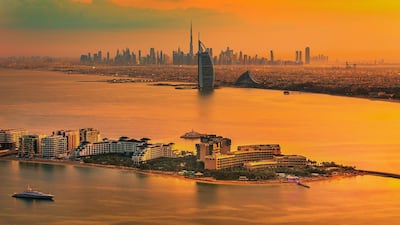The number of the international visitors to Dubai exceeded the pre-pandemic level in the first half of this year as the emirate's hospitality and tourism sector posted a record performance.
International visits to Dubai, the commercial and leisure hub of the Middle East, rose 20 per cent on an annual basis during the first half of the year, the Dubai Media office said on Sunday, quoting the latest data from the Dubai’s Department of Economy and Tourism (DET).
The emirate said there were 8.55 million international visitors in the January-to-June period this year, the best first-half performance yet, exceeding the pre-pandemic figure of 8.36 million tourists in the first half of 2019.
“The remarkable surge in international visitors witnessed by Dubai in the first half of 2023 further demonstrates its emergence as one of the brightest spots, not only in the worldwide tourism sector, but also the broader global economic landscape,” Sheikh Hamdan bin Mohammed, Crown Prince of Dubai, said.
The sharp annual increase in international visitors contributes to the goal of the Dubai Economic Agenda 2033 that aims to consolidate the emirate’s position as one of the world’s top three cities.
“The record first-half performance reflects the successful and diverse citywide drive to market the destination, with the unwavering support of stakeholders and partners,” the media office said.
Data reaffirms Dubai’s position as the world's fastest recovering destination, and far exceeds the projection made by the UN and the World Trade Organisation that estimated international tourist arrivals of between 80 per cent to 95 per cent of pre-pandemic levels this year.
“While the growth of international visitation reinforces Dubai’s rise as a major global tourism destination, it also signifies its status as a pivotal hub for trade, investment and enterprise,” Sheikh Hamdan, who is also the Chairman of The Executive Council of Dubai, said.
“The Dubai Economic Agenda D33 … has outlined an ambitious new trajectory for the city to further consolidate its status as one of the world’s top urban economies and tourism destinations. As a major pillar of Dubai’s economy, the tourism sector will continue to play a key role in realising its future aspirations.”
Dubai's economy, which has bounced back strongly from the pandemic driven slowdown, is estimated to have grown 5 per cent last year and is forecast to increase by 3.5 per cent in 2023, according to Emirates NBD.
The emirate's economy expanded by 4.6 per cent on an annual basis in the first nine months of 2022, data from the Dubai Statistics Centre shows.
Business activity in Dubai's non-oil private sector economy also rose to a 10-month high in June, boosted by a sharp rise in sales and new orders as demand growth quickened.
The emirate's seasonally adjusted S&P Global purchasing managers' index reading rose to 56.9 in June, from 55.3 in May, marking the strongest overall improvement in operating conditions in the non-oil sector since August 2022.
Dubai International Airport has also increased its annual passenger forecast for this year after hitting 95.6 per cent of its pre-pandemic levels of traffic in the first quarter of 2023.
The airport handled 21.2 million passengers during the first three months of the year, up 55.8 per cent from the first quarter of 2022.

The latest data showed visitors from western Europe were the biggest contributor to tourism arrivals, making up 20 per cent of the total international guests, while the GCC and Mena regions delivered a combined 28 per cent of the regional share.
South Asia accounted for a 17 per cent share of the total, and Russia, Central Asian States, and eastern Europe combined contributed 14 per cent. North and South-east Asia contributed 8 per cent, while the Americas, Africa and Australasia contributed 7 per cent, 4 per cent and 2 per cent, respectively, according to the DET data.
Hotels in the emirate also outperformed pre-pandemic levels across all hospitality measures in the first half of this year, including occupancy, average daily rate (ADR), revenue per available room (RevPAR) and length of stay.
At 78 per cent, Dubai hotels’ average occupancy was 2.2 percentage points higher than the occupancy achieved before the pandemic.
The number of hotel establishments grew by the 13 per cent to 810, while room capacity rose by 26 per cent to 148,689 compared with the same period in 2019.
The ADR of Dh534 during the first six months of the year surpassed the ADR of first half of 2019 at Dh444, while RevPar of Dh415 was a 24 per cent increase compared to the first six months of the pre-pandemic period, according to the DET data.
“This significant uplift in visitation, which surpasses both pre-pandemic levels and marks a record for Dubai’s tourism sector, is the result of a highly co-ordinated, sustainable and robust strategy, that is underpinned by a strong execution mandate,” Helal Almarri, director general of DET, said.
“These results further add weight to the depth, scale and resilience of Dubai’s tourism ecosystem, both domestically and across the world.”


